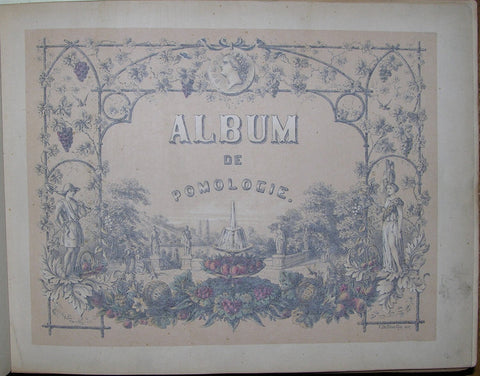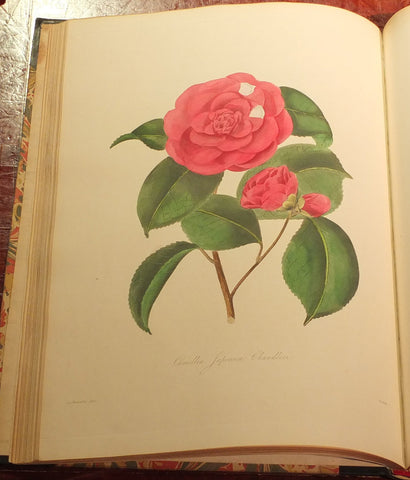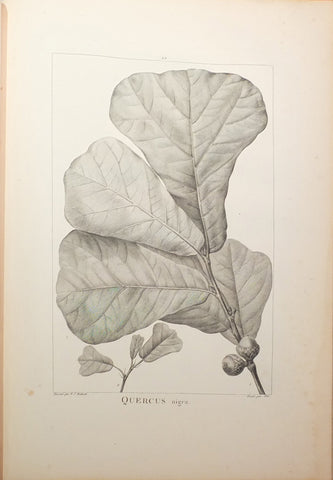Robert John Thornton (1768-1837), Temple of Flora, or, Garden of the Botanist, Poet, Painter, and Philosopher
Robert John Thornton (1768-1837)
Temple of Flora, or, Garden of the Botanist, Poet, Painter, and Philosopher
Large 4to (15 2/8 x 12 2/8 inches). Aquatint frontispiece by Cosway after Burke (misbound), engraved title-page over two leaves with vignette headpiece to first leaf by Tomkins after Burney; 2 stipple engravings by Russell and Opie after Maddocks, and Reinagle after Bartolozzi and Landseer, 28 hand-colored aquatints by Pether, Thornton, Edwards, Reinagle & Henderson, after drawings by Dunkarten, Roffe, Gaugain, Quilley, Maddox, Burk, Maddan and Stadler (lightly browned, marginal thumbing throughout). Contemporary tan calf decorated in gilt and blind (rebacked, extremities quite worn with loss, surface abrasions).
Provenance: modern ownership inscription at the head of the title-page.
THORNTON'S MASTERPIECE
First quarto edition, with an additional plate: "Artichoke Protea" by Quilley after Henderson, not included in the original folio edition of 1807 published under the title "New Illustrations of the Sexual System of Linnaeus". Other images are reduced copies of those in the folio edition. According to Dunthorne, the quarto edition was published initially as fourth level prizes in the lottery that Thornton ran in an attempt to recoup the losses he had incurred during the production of the folio edition. Thornton's "Temple of Flora" was a "gigantic literary speculation which was to ruin him. This work, ... was first advertised in 1797 and began to appear in parts from 1799, published by T. Bensley and priced at 1 guinea (later 25s). The complete text with illustrations was advertised as available in 1799 for 20 guineas. Its bibliographic history was complicated, the three main parts being issued at a variety of times and in different formats. ... The huge costs of illustration and printing seriously eroded Thornton's personal fortune. As a promotional exercise in 1804 he exhibited the originals of his plates at 49 New Bond Street, and in 1811 an act of parliament (51 George III, cap. 103) authorized his 'Royal Botanical Lottery', for which he issued 20,000 tickets at 2 guineas each. The top prize was the set of original paintings, with other prizes of his printed illustrations and texts. In spite of his efforts to market his publications, his finances never recovered. At the heart of the New Illustration was Thornton's scheme to produce a specifically British botanical publication of a magnificence to surpass all previous examples. Teams of master engravers and colourists, including Francesco Bartolozzi, Richard Earlom, and John Landseer, used the full range of modern printing techniques to produce coloured illustrations after paintings by such prominent artists as Sir William Beechey, James Opie, Henry Raeburn, John Russell, Abraham Pether, and his two favoured illustrators, Peter Henderson and Philip Reinagle. The illustrations were not restricted to the 'choicest flowers' in the world, but included portraits of eminent botanists-including the famous portrait of Linnaeus in Lapp (Sami) dress-elaborate allegories, such as 'Cupid Inspiring the Plants to Love', and a bust of Linnaeus being honoured by Aesculapius, Flora, Ceres, and Cupid. The text, which includes a translation of Linnaeus's 'Prize dissertation' on the sexuality of plants (1759), is similarly not bound to accounts and texts of scientific botany, but deals with a wide range of religious, political, spiritual, social, and emotional issues, not only in prose but also through extensive use of poems by modern and ancient authors. It is easy to regard much of this material as irrelevant to the publication's botanical aims, but this is to miss the universal human and religious purposes of botanical learning in Thornton's system of thought" (Martin Kemp for DNB).
Thornton was destined for a career in the church, but while at Trinity College, Cambridge he found inspiration in the botanical lectures of Thomas Martyn and switched to studying medicine. He went on to lecture in medical botany at Guy's Hospital. Conceived on a grandiose scale, Thornton's work was to comprise three parts: a dissertation on the sexual reproductive cycle of plates; an explanation of Linnaeus's plant system, lavishly illustrated with botanical plates and portraits of botanists; and "The Temple of Flora" which was to have no less than seventy large plates of exotic plant species arranged according to the classification system of Linnaeus. Each species was to appear in its native environment. The production of the plates for "The Temple of Flora" involved a variety of techniques - aquatint, mezzotint, stipple engraving and stippling with line engraving or etching which required the participation of a large number of artists. Among those commissioned by Thornton were Philip Reinagle - who executed most of the preparatory drawings - Abraham Pether (known for his moody, quasi-Gothic landscapes), Sydenham Edwards (see lots 26 and 32), and Peter Henderson (see lot 29), and the engravers Richard Earlom, James Caldwall, and Thomas Burke. Only the plate of the Rose was drawn by Thornton and executed by Earlom. In spite of using a host of artists and engravers, Thornton managed to "maintain a remarkable homogeneity of style throughout" (An Oak Spring Flora), but production was a protracted stop-and-go affair, causing the text and plates to appear irregularly, and to bring Thornton ultimately to the brink of personal bankruptcy. Because some plates were withdrawn or reworked in the course of publication, it is not possible to establish a definitive collation of the work. For his contribution to English botanical illustration, Thornton has been compared to Redouté by Alan Thomas: "more or less coeval with Redouté in France came the production of the greatest English colour-plate flower book... What Redouté produced under the patronage of L'Héritier, Marie Antoinette, the Empress Josephine, Charles X and the Duchesse de Berry, Thornton set out to do alone. The result was almost total failure. His fortune was engulfed and his family reduced to penury... It is easy to raise one's eyebrows at Thornton's unworldly and injudicious approach to publishing... but he produced... the most strikingly beautiful set of flower plates ever to be printed in England [and] one of the loveliest books in the world" (Great Books and Book Collectors pp. 142). Stafleu TL2 14.283; Great Flower Books, p.77; Dunthorne 302.
We Also Recommend
















